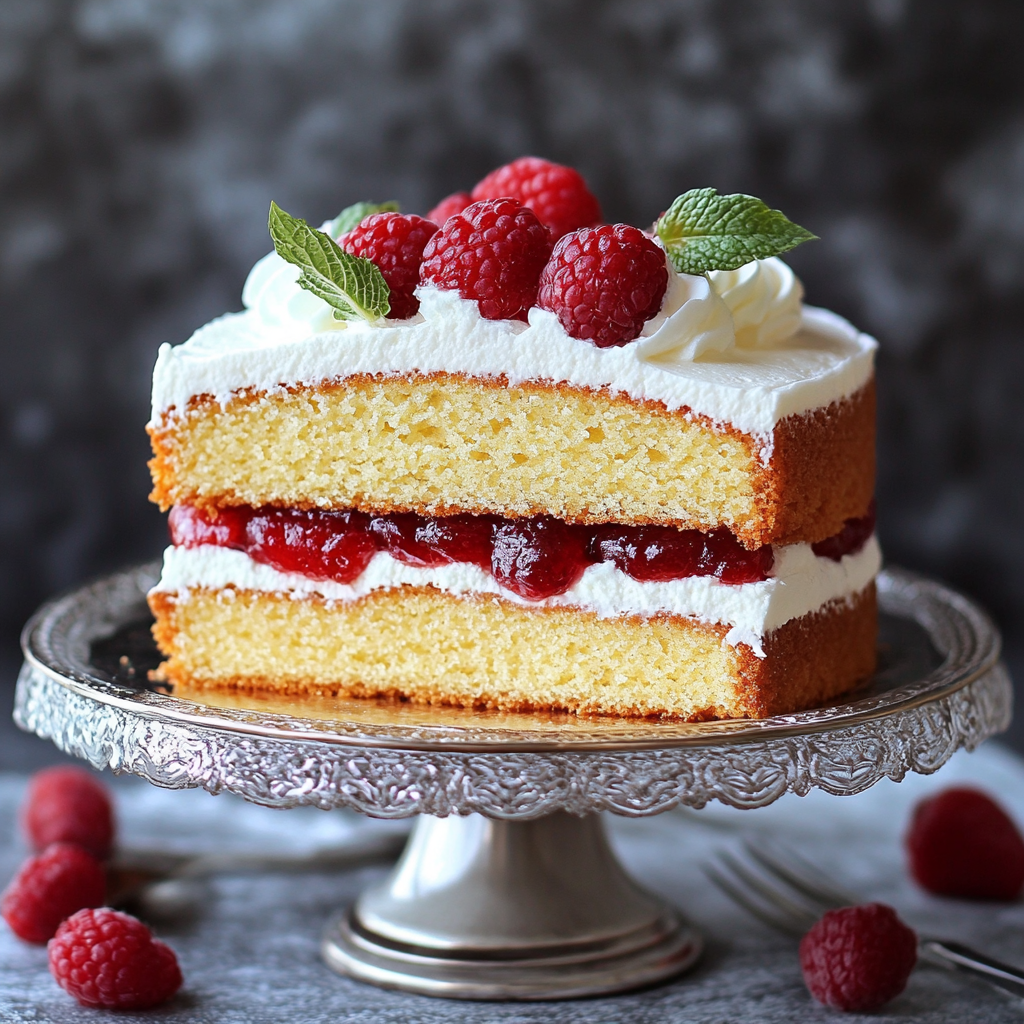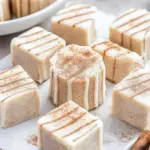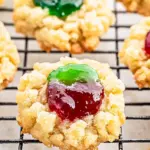Victoria Sponge Cake: A British Classic for Every Occasion
The Victoria Sponge Cake, or simply “Victoria Sponge,” is one of the most iconic desserts in British baking. Known for its light and fluffy texture, combined with rich cream and sweet jam, this cake has stood the test of time and remains a staple at afternoon teas, birthdays, and celebrations across the UK. In this article, we will explore the origins, cultural significance, variations, and tips for making the perfect Victoria Sponge Cake.
The Origins of Victoria Sponge Cake
The history of the Victoria Sponge Cake dates back to the 19th century. It is believed to have been named after Queen Victoria, who was known to enjoy a slice of this delicious treat with her afternoon tea. According to historical accounts, Queen Victoria’s personal cook, Mrs. Beeton, popularized the cake during the Queen’s reign in the 1800s. This cake was part of the era’s growing trend of afternoon tea, which became a fashionable social event among the British elite.
While it’s often said that Queen Victoria herself enjoyed the cake, there is no definitive evidence that she specifically requested it. However, the cake became a symbol of British culinary sophistication and was frequently served during royal gatherings and social events. It gained its “sponge” reputation due to the lightness and airy texture of the cake, which was in stark contrast to the heavier, dense cakes that were common in earlier centuries.
The Anatomy of a Victoria Sponge Cake
At its core, the Victoria Sponge Cake is a simple yet elegant dessert. It traditionally consists of two layers of sponge cake, filled with strawberry or raspberry jam, and topped with a layer of whipped cream. The beauty of the Victoria Sponge lies in its simplicity. The cake itself is light, airy, and slightly sweet, while the jam adds a burst of fruity sweetness, and the whipped cream brings a rich, creamy texture. The cake is typically dusted with powdered sugar for an added touch of sweetness and visual appeal.
Although the cake’s structure remains largely unchanged, variations of the Victoria Sponge have evolved over the years. Some versions include fresh fruit such as strawberries or raspberries, while others use a variety of jams. The traditional recipe calls for strawberry jam, but raspberry, apricot, or even blackberry jams are popular alternatives. The cream filling may also vary, with some bakers opting for buttercream instead of whipped cream, or adding a dash of vanilla or almond extract to the filling for extra flavor.
Cultural Significance of the Victoria Sponge Cake
The Victoria Sponge Cake is deeply ingrained in British culture, particularly as part of the afternoon tea tradition. Afternoon tea, which originated in the early 19th century, was a social event that involved a variety of small cakes, sandwiches, and tea served in the late afternoon. Queen Victoria herself is said to have popularized the afternoon tea tradition, and as a result, the Victoria Sponge Cake became an essential component of this ritual.
Today, the Victoria Sponge Cake is synonymous with British hospitality and is a symbol of comfort and tradition. It is a cake that is often made for special occasions, such as birthdays, weddings, and national celebrations like the Queen’s birthday or Royal Ascot. Additionally, it has become a beloved treat for tea parties, whether casual or more formal. There is no better way to welcome guests into your home than with a freshly baked Victoria Sponge.
The Secret to a Perfect Victoria Sponge
The secret to making a perfect Victoria Sponge Cake lies in achieving the right balance of texture and flavor. The cake must be light and airy but not dry. Here are some key tips for perfecting this classic dessert:
-
Use room temperature ingredients: To ensure the cake batter comes together smoothly, it’s important to use ingredients that are at room temperature. Cold butter, eggs, and milk can cause the batter to seize up and result in a dense cake.
-
Don’t overmix the batter: When preparing the batter, it’s crucial to mix only until the ingredients are combined. Overmixing can lead to a dense and heavy cake, which is the opposite of what you want in a Victoria Sponge.
-
Sift the flour: Sifting the flour helps to incorporate air into the dry ingredients, which contributes to the light texture of the cake. Sifting also helps prevent any clumps of flour, ensuring a smooth batter.
-
Use the right pan: A round cake tin with a good non-stick coating is essential for achieving an even bake. It’s important to grease and flour the pan to prevent the cake from sticking.
-
Let the cake cool completely: Once the cakes are baked, it’s essential to let them cool completely before assembling the sponge. If the cake is still warm, the whipped cream can melt and create a soggy cake.
-
Choose the right jam: The choice of jam can make a big difference in the flavor of your Victoria Sponge. Traditional strawberry jam is a classic choice, but other fruit jams like raspberry, apricot, or even lemon curd can be used for a unique twist.
-
Whip the cream properly: If you’re using fresh whipped cream, it’s important not to overwhip it. Overwhipping can cause the cream to separate and turn grainy. Aim for soft peaks for a smooth and silky texture.
Variations of the Victoria Sponge Cake
Though the Victoria Sponge Cake remains a timeless classic, there are several variations that add unique twists to the original recipe. Here are some popular variations:
-
Flavored Sponge Cake: While the traditional Victoria Sponge uses a simple vanilla sponge, you can experiment by adding flavorings such as lemon zest, almond extract, or even a splash of rum to the cake batter.
-
Chocolate Victoria Sponge: For chocolate lovers, a chocolate variation of the Victoria Sponge Cake can be made by adding cocoa powder to the cake batter. This creates a rich, chocolatey flavor that pairs wonderfully with cream and jam.
-
Fruit Variations: You can take the classic Victoria Sponge to the next level by adding fresh fruit to the filling. Fresh strawberries, raspberries, or even blueberries can be layered with whipped cream and jam for an extra burst of flavor.
-
Buttercream Filling: While whipped cream is the traditional filling, you can opt for a rich buttercream frosting instead. This adds a thicker texture and a sweeter flavor, making it ideal for those who prefer a more indulgent cake.
-
Mini Victoria Sponges: For a fun twist, you can bake individual mini Victoria Sponges. These single-serving cakes are perfect for afternoon tea parties or as a personal treat.
Serving Suggestions
The Victoria Sponge Cake is versatile when it comes to serving. Traditionally, it is served as part of afternoon tea alongside finger sandwiches, scones, and a pot of tea. However, it can also be served at celebrations like birthdays, weddings, or tea parties.
To elevate the presentation, consider dusting the top of the cake with a light coating of powdered sugar and garnishing with fresh berries or edible flowers. Pair it with a hot cup of tea, or if you’re serving it as a dessert, a glass of sparkling wine or Champagne would complement the cake beautifully.
Conclusion:
The Victoria Sponge Cake remains a quintessential part of British baking, cherished for its simplicity and elegance. Its airy texture, sweet jam, and creamy filling make it a timeless dessert for any occasion. Whether you’re serving it at a traditional afternoon tea or making it for a birthday or celebration, the Victoria Sponge Cake never fails to impress. By following a few key tips, you can perfect this classic cake and create a delicious treat that will be enjoyed by friends and family for generations to come.
The Victoria Sponge Cake is more than just a dessert; it’s a celebration of British culinary history, and its enduring popularity is a testament to its deliciousness. So, why not try your hand at baking one today and experience the joy that comes with making this classic British cake.






